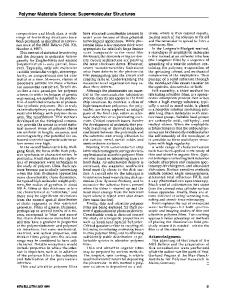Synthesis and Characterization of NanoComposite Superhard Materials
- PDF / 1,206,335 Bytes
- 14 Pages / 612 x 792 pts (letter) Page_size
- 69 Downloads / 391 Views
0987-PP01-11
Synthesis and Characterization of NanoComposite Superhard Materials Yusheng Zhao1, Duanwei He2, Jiang Qian3, and Jianzhong Zhang1 1 Los Alamos Neutron Science Center, Los Alamos National Laboratory, LANSCE-LC, MSH805, Los Alamos, NM, 87545 2 Institute of Atomic and Molecular Physics, Sichuan University, Chendu, Sichuan Province, 610065, China, People's Republic of 3 US Synthetic, 1260 South 1600 West, Orem, UT, 84058 ABSTRACT We have developed a novel method of reactive sintering under high pressure and high temperature conditions and have successfully synthesized bulk and nanostructured BC2N, BC4N, and diamond-SiC composites. The keys to this success are the careful preparation of precursor materials through high energy ball-milling and sensible tuning of the sintering conditions (pressure, temperature, and sintering time), leading to the formation of nano-scale features in the final synthesis products. The indentation measurements indicate that BC2N and BC4N have the Vickers hardness of 62 and 68 GPa, respectively, making them the second hardest materials known, second only to diamond. The high P-T reactive sintering results in a nanostructured diamond-SiC composite of high uniformity, low porosity, minimum residual silicon, and minimal quantities of graphite. It tunes subtle interplays of P-T-t to have fine control of thermodynamics and kinetics in the formation of diamond-SiC nanocomposites with nanocrystalline SiC matrix. The surface defects of micron/nano-diamonds are consumed by amorphous/molten silicon in the formation of nanocrystalline SiC matrix. It in turn greatly reduces the forming/mobility of microcracks thus leads to significant enhancement of fracture toughness (by as much as 50%) of the nano-composites without much compromising of hardness. The present study shows how to design/proceed a well controlled nano-synthesis so as to achieve great improvement in nano-mechanics for advance technological applications. INTRODUCTION Superhard materials are commonly defined as materials with the Vickers hardness (Hv) exceeding 40 GPa. Diamond is the hardest material known (Hv = 60 – 120 GPa) and has the highest bulk modulus of 443 GPa (i.e., lowest compressibility) and the highest shear modulus (535 GPa). In addition to hardness, diamond has unique electronic and thermal properties. It has a wide band-gap of 5.47 eV. Chemically pure diamond exhibits the highest room-temperature thermal conductivity, five times higher than that of silver, the best metallic conductor. These combined properties make diamonds highly desirable as industrial materials and being widely used as super-abrasives in automotive, aerospace, ceramics, and glass industries, and recently as heat sinks and high-temperature semiconductors in the electrical and electronic industries as well. However, diamonds are also known for their weaknesses of low fracture toughness, limited thermal stability, and ultra reactivity in ferric and ferrous machining. These drawbacks seriously limit the diamond applications. Since the successful syn
Data Loading...











